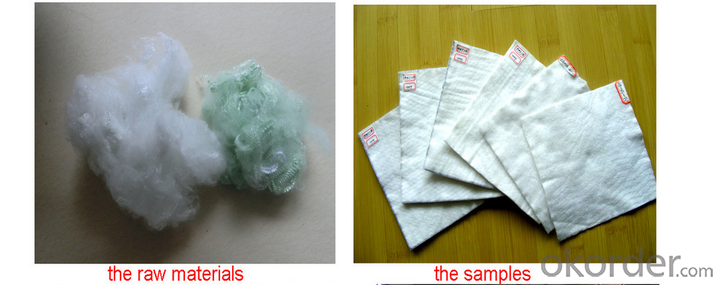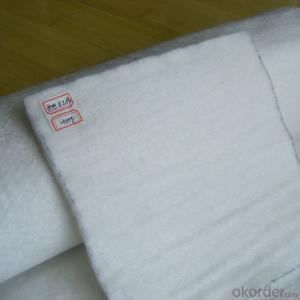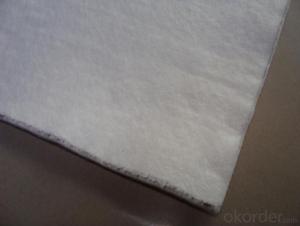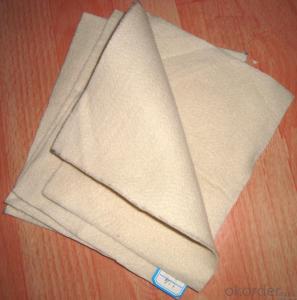Home Textile Eco-Friendly Antislip Non Toxic Nonwoven Geotextile
- Loading Port:
- Tianjin
- Payment Terms:
- TT OR LC
- Min Order Qty:
- 5000 g/m²
- Supply Capability:
- 10000 g/m²/month
OKorder Service Pledge
OKorder Financial Service
You Might Also Like
Packaging & Delivery
| Packaging Detail: | roll, fold |
| Delivery Detail: | within 15 days |

Specifications
PP Polyester woven geotextile,filtration,separation,reinforcement,erosion control
PP Polyester woven geotextile, and we sew woven geotextile into geotube,geobag, large area(panel) geotextile.
Geobag/tube:
specification: rectangle shape 4MX6M, cylinder diameter can be 3/4/5M, length to 30m, cubic shape .per your instructions.
Sewn from high tensile woven geotextile.

Woven Geotextile
Material:PP, PET
Color: white,other colors available
Width:1.06-3.7M
Weight: PP 200gsm-1400gsm,Polyester 90gsm-1500gsm
Tensile strength: PP 40KN/M-400KN/M,Polyester<500KN/M permeability:KX10-2-10-5 cm/s, K=1.0-9.9
Pore size: 0.07-0.5mm
Elongation: PP<35%, Polyester<15%< div="">
interweave method:plain, twill etc.
Benefits:filtration,separation,reinforcement,erosion control
Civil and environmental applications including highways, port facilities, reservoir, transport construction, waste and chemical management, subgrade engineering, coastal protection works, peninsula shoal engineering, subsurface drainage ,pile jacketing etc..
FAQ:
♦ Payment terms: by T/T or L/C |
♦ MOQ:2000 SQM |
♦ If you are interested in our products ,pls advice me the technical index,product weight etc,the more information the better..... |
- Q:How do geotextiles contribute to the cost-effectiveness of construction projects?
- Geotextiles contribute to the cost-effectiveness of construction projects by providing various benefits. They act as a barrier against soil erosion, reducing the need for expensive erosion control measures. Geotextiles also enhance soil stability, allowing for the use of less expensive and readily available fill materials. Additionally, they improve drainage and filtration, minimizing the need for costly drainage systems. Overall, geotextiles help optimize construction processes, reduce material and labor costs, and extend the lifespan of structures, making them a cost-effective choice for construction projects.
- Q:Geotextile, one ton, replaced by a square meter how much money formula
- How many grams of geotextile
- Q:What is geomembrane geomembrane, composite geomembrane
- What is geomembrane geomembrane, composite geomembrane
- Q:What are the factors to consider when selecting geotextiles for mining applications?
- When selecting geotextiles for mining applications, factors to consider include the type and size of particles being contained or separated, the required strength and durability of the geotextile, the level of permeability needed, the potential for chemical or biological degradation, and the site-specific conditions such as slope stability and groundwater levels. Additionally, the cost-effectiveness and ease of installation should also be taken into account.
- Q:Can geotextiles be used for soil reinforcement in embankments?
- Yes, geotextiles can be used for soil reinforcement in embankments. Geotextiles are commonly used in civil engineering projects to improve the stability and strength of soil structures. They are effective in preventing soil erosion, enhancing drainage, and distributing loads, making them suitable for reinforcing embankments and preventing slope failures.
- Q:Tunnel without sand concrete, geotextile, seepage blind pipe construction sequence
- Hello, according to the question you ask, the construction sequence should be the first laying of seepage blind pipe and then laying geotextile, and finally pouring no sand concrete. Geotextile laying in the osmosis above the main pipe is to play the role of filtration and protection, to prevent seepage blind pipe plug. There are a lot of sites in order to better ensure that the blind water pipe is not blocked in the osmosis blind tube outside the layer of geotextile wrapped.
- Q:How do geotextiles help in soil stabilization?
- Geotextiles help in soil stabilization by acting as a barrier between soil layers, preventing erosion and promoting the consolidation of the soil. They enhance soil strength, reduce soil settlement, and improve drainage, ultimately ensuring better stability and longevity of structures built on or with the support of the soil.
- Q:Can geotextiles be used in the protection of underground tanks?
- Yes, geotextiles can be used in the protection of underground tanks. Geotextiles are often used as a protective layer in tank installations to prevent damage from sharp objects, provide a barrier against soil contaminants, and help with drainage and filtration.
- Q:Geotextile packaging what are the requirements
- Geotextile packaging requirements are as follows: 1, staple acupuncture non-woven geotextile according to set into a long volume of packaging. The fixed length shall be determined in accordance with the product specification or the parties concerned. 2, the product of the splicing rate should be less than 15%, the total length of each piece of stitching products should be 7.1.1 fixed length plus 1m or more, every 100m to allow splicing 2, or by the supply and demand sides to determine. 3, the length of the product in the 30m below a small package can be a separate package, for a head treatment, 4, product packaging should ensure that no scattered, no damage, no pollution. Users have special requirements, the supply and demand sides to determine the consultation.
- Q:Can geotextiles be used in agricultural drainage systems?
- Yes, geotextiles can be used in agricultural drainage systems. Geotextiles are permeable fabrics that can be installed to improve soil drainage by allowing water to pass through while preventing soil erosion. They can be used as a filter around drainage pipes to prevent soil particles from clogging the system, thus enhancing the effectiveness and longevity of the agricultural drainage system.
1. Manufacturer Overview |
|
|---|---|
| Location | |
| Year Established | |
| Annual Output Value | |
| Main Markets | |
| Company Certifications | |
2. Manufacturer Certificates |
|
|---|---|
| a) Certification Name | |
| Range | |
| Reference | |
| Validity Period | |
3. Manufacturer Capability |
|
|---|---|
| a)Trade Capacity | |
| Nearest Port | |
| Export Percentage | |
| No.of Employees in Trade Department | |
| Language Spoken: | |
| b)Factory Information | |
| Factory Size: | |
| No. of Production Lines | |
| Contract Manufacturing | |
| Product Price Range | |
Send your message to us
Home Textile Eco-Friendly Antislip Non Toxic Nonwoven Geotextile
- Loading Port:
- Tianjin
- Payment Terms:
- TT OR LC
- Min Order Qty:
- 5000 g/m²
- Supply Capability:
- 10000 g/m²/month
OKorder Service Pledge
OKorder Financial Service
Similar products
New products
Hot products
Related keywords































